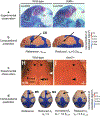A coupled reaction-diffusion-strain model predicts cranial vault formation in development and disease
- PMID: 31006064
- PMCID: PMC6625897
- DOI: 10.1007/s10237-019-01139-z
A coupled reaction-diffusion-strain model predicts cranial vault formation in development and disease
Abstract
How cells utilize instructions provided by genes and integrate mechanical forces generated by tissue growth to produce morphology is a fundamental question of biology. Dermal bones of the vertebrate cranial vault are formed through the direct differentiation of mesenchymal cells on the neural surface into osteoblasts through intramembranous ossification. Here we join a self-organizing Turing mechanism, computational biomechanics, and experimental data to produce a 3D representative model of the growing cerebral surface, cranial vault bones, and sutures. We show how changes in single parameters regulating signaling during osteoblast differentiation and bone formation may explain cranial vault shape variation in craniofacial disorders. A key result is that toggling a parameter in our model results in closure of a cranial vault suture, an event that occurred during evolution of the cranial vault and that occurs in craniofacial disorders. Our approach provides an initial and important step toward integrating biomechanics into the genotype phenotype map to explain the production of variation in head morphology by developmental mechanisms.
Keywords: Brain; Computational morphogenesis; Craniosynostosis; Finite volume method; Intramembranous ossification; Mouse model; Skull growth and evolution.
Figures







Similar articles
-
A COMPUTATIONAL ANALYSIS OF BONE FORMATION IN THE CRANIAL VAULT USING A COUPLED REACTION-DIFFUSION-STRAIN MODEL.J Mech Med Biol. 2017 Jun;17(4):1750073. doi: 10.1142/S0219519417500737. Epub 2017 May 29. J Mech Med Biol. 2017. PMID: 29225392 Free PMC article.
-
Increased FGF8 signaling promotes chondrogenic rather than osteogenic development in the embryonic skull.Dis Model Mech. 2018 Jun 15;11(6):dmm031526. doi: 10.1242/dmm.031526. Dis Model Mech. 2018. PMID: 29752281 Free PMC article.
-
Flat bones and sutures formation in the human cranial vault during prenatal development and infancy: A computational model.J Theor Biol. 2016 Mar 21;393:127-44. doi: 10.1016/j.jtbi.2016.01.006. Epub 2016 Jan 15. J Theor Biol. 2016. PMID: 26780653
-
Growth of the normal skull vault and its alteration in craniosynostosis: insights from human genetics and experimental studies.J Anat. 2005 Nov;207(5):637-53. doi: 10.1111/j.1469-7580.2005.00475.x. J Anat. 2005. PMID: 16313397 Free PMC article. Review.
-
The Development of the Calvarial Bones and Sutures and the Pathophysiology of Craniosynostosis.Curr Top Dev Biol. 2015;115:131-56. doi: 10.1016/bs.ctdb.2015.07.004. Epub 2015 Oct 1. Curr Top Dev Biol. 2015. PMID: 26589924 Review.
Cited by
-
Skeletal-Vascular Interactions in Bone Development, Homeostasis, and Pathological Destruction.Int J Mol Sci. 2023 Jun 30;24(13):10912. doi: 10.3390/ijms241310912. Int J Mol Sci. 2023. PMID: 37446097 Free PMC article. Review.
-
The developing mouse coronal suture at single-cell resolution.Nat Commun. 2021 Aug 10;12(1):4797. doi: 10.1038/s41467-021-24917-9. Nat Commun. 2021. PMID: 34376651 Free PMC article.
-
Making and shaping endochondral and intramembranous bones.Dev Dyn. 2021 Mar;250(3):414-449. doi: 10.1002/dvdy.278. Epub 2020 Dec 28. Dev Dyn. 2021. PMID: 33314394 Free PMC article. Review.
-
Ontogenetic and in silico models of spatial-packing in the hypermuscular mouse skull.J Anat. 2021 Jun;238(6):1284-1295. doi: 10.1111/joa.13393. Epub 2021 Jan 13. J Anat. 2021. PMID: 33438210 Free PMC article.
-
From mesenchymal niches to engineered in vitro model systems: Exploring and exploiting biomechanical regulation of vertebrate hedgehog signalling.Mater Today Bio. 2022 Nov 22;17:100502. doi: 10.1016/j.mtbio.2022.100502. eCollection 2022 Dec 15. Mater Today Bio. 2022. PMID: 36457847 Free PMC article.
References
-
- Aldridge K, Hill CA, Austin JR, Percival C, Martinez-Abadias N, Neuberger T, Wang Y, Jabs EW, Richtsmeier JT (2010) Brain phenotypes in two FGFR2 mouse models for Apert syndrome. Developmental dynamics : an official publication of the American Association of Anatomists 239(3):987–997, DOI 10.1002/dvdy.22218 - DOI - PMC - PubMed
-
- Carroll S, Grenier J, Weatherbee S (2004) From DNA to diversity: molecular genetics and the evolution of animal design Blackwell Publishers, DOI 10.1093/jhered/esi101 - DOI
MeSH terms
Grants and funding
LinkOut - more resources
Full Text Sources
Medical

